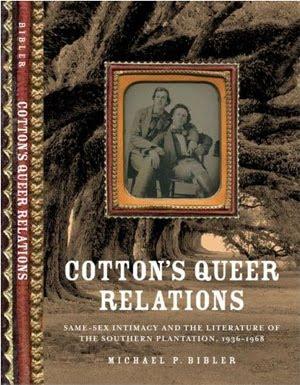Cotton’s Queer Relations: Same-Sex Intimacy and the Literature of the Southern Plantation, 1936-1968

As Michael Bibler mentions in the introduction to Cotton’s Queer Relations, it seems impossible that there could be enough material out there to serve as the basis for such depth of criticism on an incredibly narrow topic. There are a few notable classics that have homoerotic undertones and even some more overt mentions of homosexual encounters that are discussed in works like The Confessions of Nat Turner, but these queer moments seem like blips in what appears to be an otherwise overtly heterosexual literary scape. Is Bibler reading too much into plantation literature? Are his examples only the result of the passionate desire to find queer meaning in texts where none exists? The answer to both questions seems to be no.
Bibler’s arguments are focused and supported with strong evidence from the texts and the work of other critics. But the argument by Bibler is more complex than a simple acknowledgment of the existence of queerness in plantation literature; he argues that the queer subtexts in plantation literature expose wider social injustices in plantation life, and that queer relations also move racial inequality and sexism to the forefront.
Bibler wants to make it clear that same-sex relations here do not necessarily mean homosexual relations. I will allow the reader of Cotton’s Queer Relations to delve more deeply into the complex reasoning behind his assertion; but in a nutshell, he essentially pleads that the closeness of same-sex relations in the textual examples he uses stand in such conflict of the heterosexualized and paternalistic structure of the plantation that they can be defined as queer even if they are not directly homosexual. It is an interesting take, and one that may initially sound like a bit of a stretch.
Terminology notwithstanding, Bibler offers fresh readings of literary classics like Absalom, Absalom! and gives contemporary insight to controversial texts like Styron’s Nat Turner. He digs deep into Cat on a Hot Tin Roof and is able to juxtapose Big Daddy’s simultaneous tolerance of homosexuality with his unabashed lack of respect toward the black servants he employs, effectively layering new meaning on a well-worn text. He picks apart the relationships of white women and their black servants in the works of Lillian Hellman, Katherine Anne Porter, and Margaret Walker, describing them as “romances”—and supports his logic—even though none of the women in the stories share an erotic lesbian moment, or even a kiss. While there are a few minor stretches here and there in Bibler’s text, he overall pleads his case. He certainly does not appear to be afraid of stirring controversy, and does a remarkable job of defending his arguments while he discusses each point.